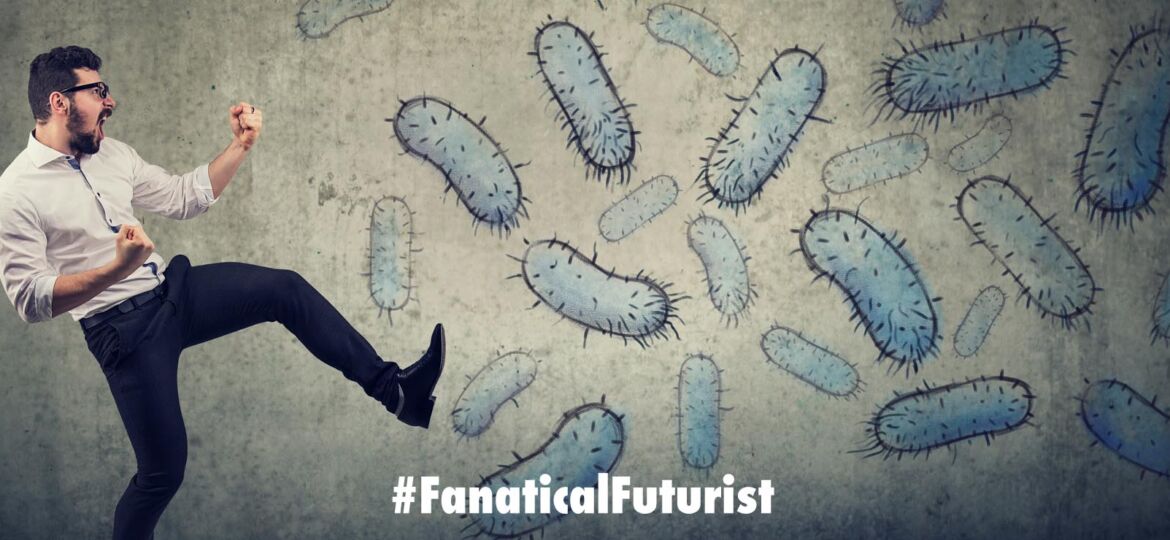
WHY THIS MATTERS IN BRIEF
Bacteria can be hard to reach, and even harder to genetically modify – until now.
 Love the Exponential Future? Join our XPotential Community, future proof yourself with courses from XPotential University, read about exponential tech and trends, connect, watch a keynote, or browse my blog.
Love the Exponential Future? Join our XPotential Community, future proof yourself with courses from XPotential University, read about exponential tech and trends, connect, watch a keynote, or browse my blog.
CRISPR, arguably the world’s most powerful gene editing technology which has been used to create everything from new crops to curing blindness, and accelerating the rate of biological evolution in mammals by millions of years, is a truly powerful synthetic biology tool. Now, scientists at North Carolina State University have demonstrated a new potential way to edit the genomes of bacteria in complex environments, by equipping viruses to hunt them down and insert the CRISPR gene-editing system.
CRISPR is a tool that allows scientists to make precise cut-and-paste edits to the genomes of living cells. It’s made possible by an enzyme that snips out a section of DNA from the target and allows it to be replaced with a new DNA strand that does something more beneficial.
The Future of Longevity and Work, by keynote Matthew Griffin
In nature, CRISPR was originally used by bacteria as a defense mechanism against viruses that prey on them, but in the new study researchers turned the tables. They engineered bacteria-hunting viruses, called Bacteriophages or Phages, which are also increasingly being used in Phage Therapy as a way to solve today’s anti-biotic resistance epidemic, that can target certain strains of bacteria and inject them with CRISPR DNA to make specific edits to their genome.
In lab tests, the phages – designated T7 and lambda – were tasked with delivering genes to E. coli that made the bacteria fluorescent, and changed their resistance to an antibiotic. And sure enough, those changes were seen in the bugs, indicating that it was working.
In the next test, the team used the lambda phage to transport what’s known as a cytosine base editor. This tool doesn’t cut the target’s DNA but changes one letter in the sequence, making for a more gentle edit to deactivate specific genes.
“We used a base editor here as a kind of programmable on-off switch for genes in E. coli,” said Matthew Nethery, lead author of the study. “Using a system like this, we can make highly precise single-letter changes to the genome without the double-strand DNA breakage commonly associated with CRISPR-Cas targeting.”
The final test was designed to simulate a more natural environment, using a fabricated ecosystem (EcoFAB). This involved loading a tank with a synthetic soil made of sand and quartz, some liquid, and three different types of bacteria, including E. coli. The goal was to test how well the phages could hunt down their targets in a more realistic environment, and whether they could single out the E. coli from the other species.
When lambda was introduced to the EcoFAB, as it’s known, it had decent success in editing the E. coli genomes, with the team reporting up to a 28 percent efficiency across the bacterial population. With further work, the researchers say this technique could eventually find use in large-scale gene editing in soil bacteria, which could have agricultural applications such as helping plants increase their nitrogen up take, or perhaps even editing the human gut microbiome to let bacteria there manufacture drugs in vivo – something that’s already a reality.
“We see this as a mechanism to aid the microbiome,” said Rodolphe Barrangou, corresponding author of the study. “We can make a change to a particular bacterium and the rest of the microbiome remains unscathed. This is a proof of concept that could be employed in any complex microbial community, which could translate into better plant health and better gastrointestinal tract health – environments of importance to food and health.”
The research was published in the journal PNAS.
Source: North Carolina State University
















